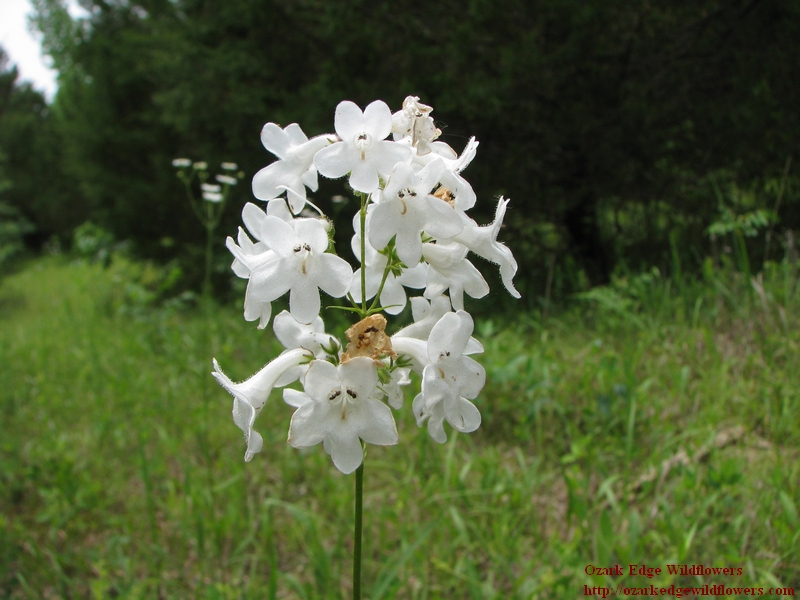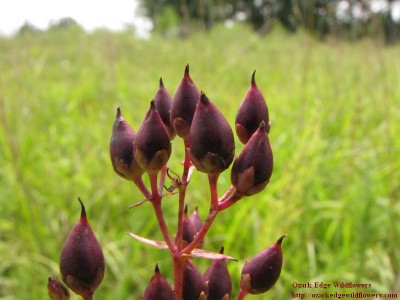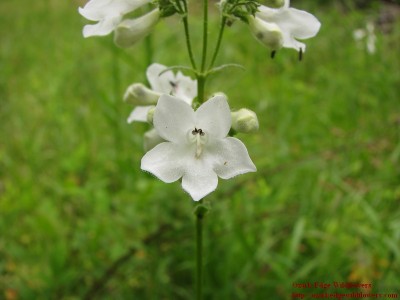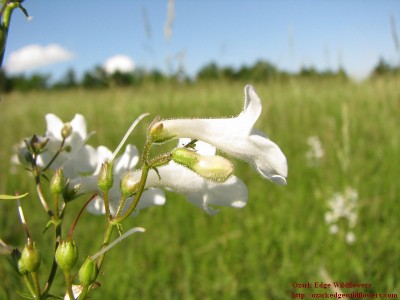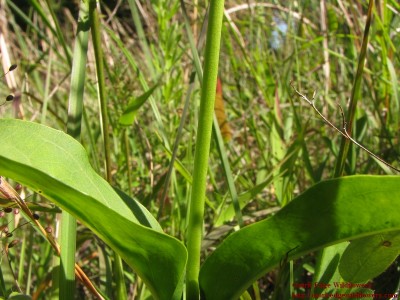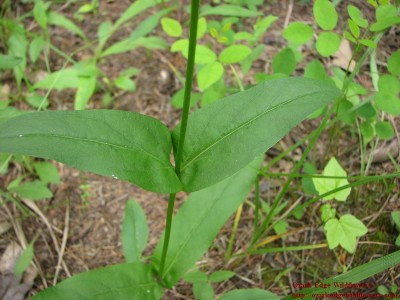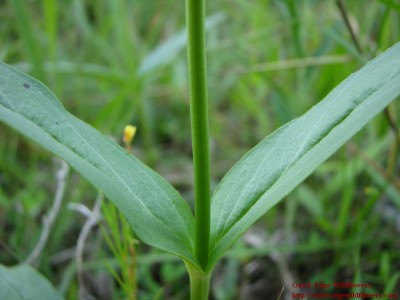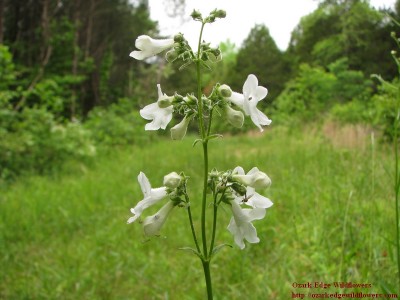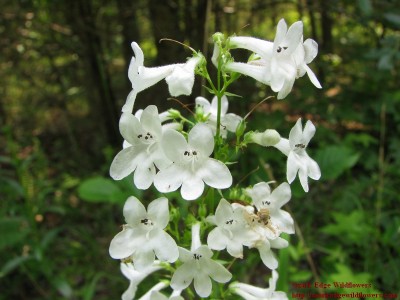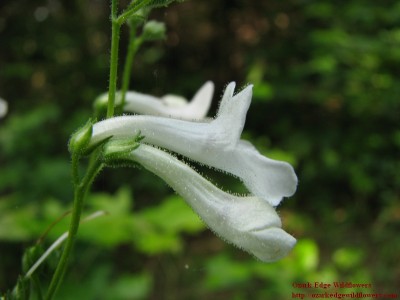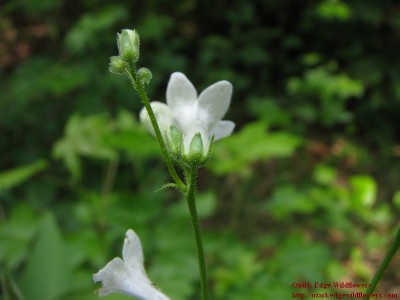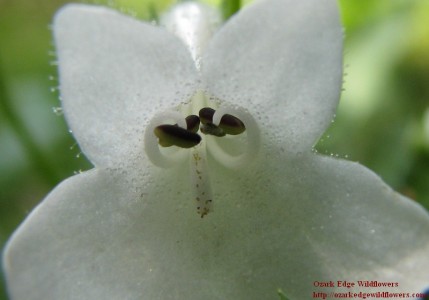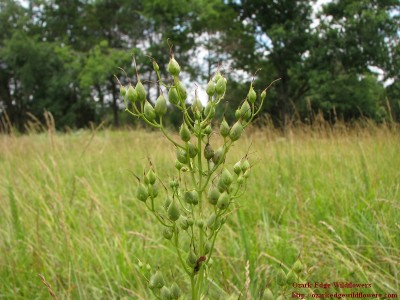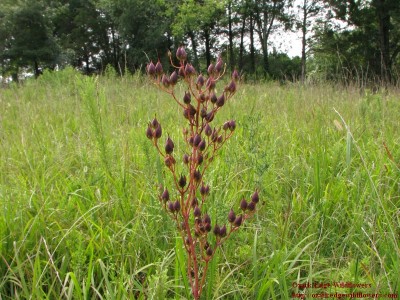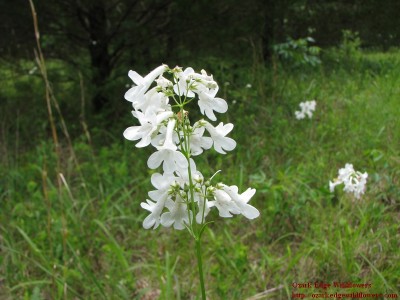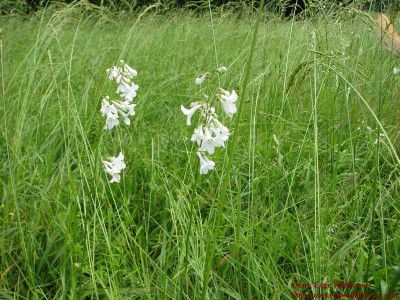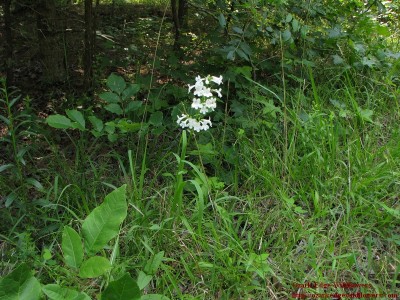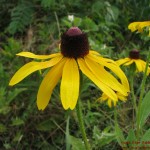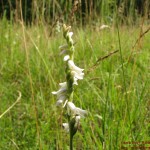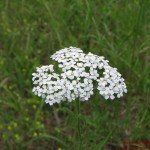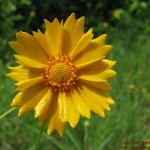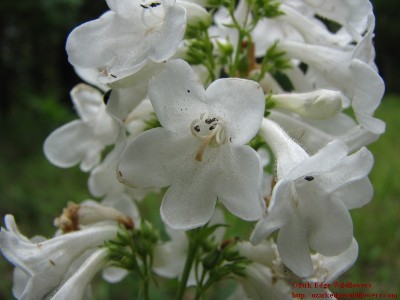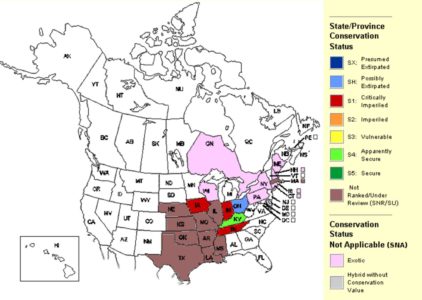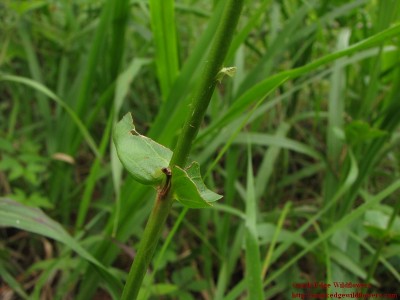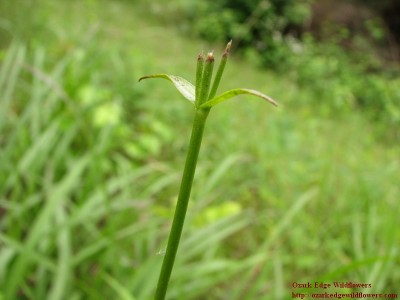There are four different white penstemons found on Ozarkedge- Penstemon pallidus, Penstemon digitalis, Penstemon tubaeflorus and Penstemon cobaea var. purpureus. Each has its own special beauty, but I do have a favorite—Penstemon tubaeflorus. Why? The showy flowers are massed on strong stems and are absolutely beautiful intermingled with the fresh green of the spring grasses. Perhaps part of my enchantment with this plant is that the show is not over with the fading of the bloom. After flowering, the seed pods emerge. They first appear as an unspectacular green, but soon turn the brilliant color of a fresh cut beet. As if that’s not enough, the stem gradually changes from green to a translucent candy apple red. This show lasts for a full month before the seed pods ripen to dark brown and release their tiny seeds.
Beet colored seed pods with translucent candy apple red stems
Latin Name/Common Name- Penstemon tubaeflorus is also spelled Penstemon tubiflorus. I believe the first spelling is correct, but you will find Google results under both names. The USDA website uses the second spelling.
The word “penstemon” is derived from the Greek words, ‘pente’ meaning five and ‘stemon’ meaning thread–which is taken to mean stamen. The word “tubaeflorus” means trumpet-flowered and the word “tubiflorus” means tube flowered.
Common names of this lovely flower are Tubed penstemon, Trumpet penstemon and White wand penstemon.
Bloom Color- The flowers of Penstemon tubaeflorus are snow white. They glisten in the sun, especially when the morning dew clings to the tiny hairs covering each blossom.
Snow white blooms contrast beautifully with spring green grass
Dew drops glisten on the flowers in early morning
Description- Penstemon tubaeflorus is a perennial growing to 3 feet tall. The stems are smooth, stout and glabrous (without hairs). The large leaves are opposite, sessile or clasping. The leaves are mostly located on the lower half of the stem, so that view of the flowers is unhindered.
Glabrous stem
Opposite leaves are oblong to lanceolate in shape
Some leaves may be partially clasping the stem
The flowers are arranged in loose panicles at the termination of the stem. Each cluster of flowers appears on an individual branch in a cylindrical pattern. The showy flowers are up to an inch in length. Each flower is pubsecent and consists of a narrow tube and large flat face. There are four stamens with curved filaments tipped by blackish anthers. The glabrous style can be seen protruding beyond the stamens. After blooming, the flowers are replaced by green seedpods. These turn the reddish purple color of a freshly cut beet and are nearly as beautiful as the flowers. Eventually, the seed pods ripen to dark brown and release their numerous tiny seeds.
Panicle of flowers
Flowers have a flat face with narrow tube
Side view showing pubescence and corolla tube
Back of flower
Curved filaments with blackish anthers and style
Seedpods are green immediately after flowering
Within a month the seedpods turn a delightful reddish purple
Bloom Time- The sparkling white flowers of Penstemon tubaeflorus can be found gracing the grasslands on Ozarkedge throughout May and June.
Each plant produces a flower spike with many individual flowers
Habitat- On Ozarkedge, Penstemon tubaeflorus is found in the prairie type fields in full sun as well as along the partially shaded woodland edge.
Grassland habitat
Woodland edge habitat
What’s Growing Nearby? Penstemon tubaeflorus has many friends that can be found in bloom nearby. Some of my favorites on Ozarkedge include Rudbeckia hirta (Blackeyed susan), Spiranthes vernalis (Spring Ladies tresses), Acillea millefolium (Yarrow), and Coreopsis grandiflora (Large-flowered coreopsis).
Rudbeckia hirta and Spiranthes vernalis
Achillea millefolium and Coreopsis grandiflora
Endangered List- Penstemon tubaeflorus is locally common within some regions, but has become severely threatened and even extirpated in others. Overall, this is not a common plant to find anymore. It’s so pretty that it has been extensively collected from the wild and picked for many bouquets. Since each plant produces but a single stem of flowers, picking that stem will result in no production of seeds from an entire plant. Other hazards faced by this plant include encroachment on its habitat by exotic, invasive species–such as Daucus carota (Queen Anne’s lace) and loss of habitat.
It has been extirpated in Indiana and Ohio and is listed as Special Concern in Tennessee. You can find more information on the USDA plant site below.
http://plants.usda.gov/java/profile?symbol=PETUT
Here’s the link to Natureserve where Penstemon tubaeflorus is listed as Possibly Extirpated in Ohio and Critically Imperiled in Iowa, Indiana and Tennessee. Unfortunately, the status is Not Ranked for Arkansas, Missouri and other states in the midwest. Obviously, there’s a lot of work to be done to document the true status of this lovely native wildflower.
Interesting Tidbits- This plant is favored by long-tongued bees such as bumblebees. A Mason bee (Osmia distincta) and a wasp (Pseuomasaris occidentalis) are oligoleges of penstemons. This means that they only gather pollen from these particular plants. You can read more about that here- http://www.answers.com/topic/bee. You might also enjoy reading John Hilty’s description at http://www.illinoiswildflowers.info/prairie/plant_index.htm#tr_penstemon.
According to John, Penstemon tubaeflorus is a nectar source for Ruby throated hummingbirds, Swallowtail butterflies, and Green metallic bees. It is a source of food for some moth caterpillars- Chalcedony Midget (Elaphria chalcedonia), Saunder’s Oncocnemis (Oncocnemis saudersiana), and Purple-Lined Sallow (Pyrrhia exprimens). He states it is of little use as a food source for mammals, but on Ozarkedge, I believe that deer or other mammals browse the plants.
This year I marked the location of several groups of plants during their flowering. When I returned to observe the seed pods, I was surprised that I could not find the plants at all! Close inspection revealed that the whole colony had been eaten nearly to the ground. You can see examples of the this below. I’m not sure what mammal ate the plants, but hopefully they are an agent to disperse the seed.
Penstemon tubaeflorus leaves have been nibbled either by moth caterpillars or herbivorous mammal
Probably some type of mammal (? deer) ate an entire colony of Penstemon tubaeflorus after flowering, leaving only a short stem
